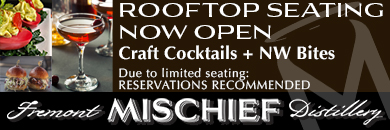by Kirby Lindsay, posted 12 September 2011

Get help creating a truly inviting yard, between Sep. 22nd and Oct. 25th, at a series of classes offered by the Woodland Park Zoo on how to build backyard habitats. With the help of experts from Seattle Audubon Society, Washington Department of Fish & Wildlife, Washington Native Plant Society, Bats Northwest, and the Zoo, attendees will learn to create certified, healthier and more sustainable environments.
The Zoo will also distribute information, and applications, tried and tested on their property – which Fremonsters can easily translate since our yards share the same topography. These classes could lead to green spaces throughout the Center of the Universe built to be more hospitable and kinder to wildlife, as well as to our pets, children and selves.
Reduce Chemicals; Increase Health

“People can take the whole series, or pick and choose,” invited Jenny Mears, Community Engagement Coordinator for the Zoo. Woodland Park offers this series each spring and fall, she explained, with the most popular classes being offered time after time, and two new topics thrown specially this fall.
The classes will contribute to Zoo neighbors incorporating the latest practices into their yards, “for the health of Puget Sound. By maintaining your garden in a sustainable way,” Mears pointed out, “it contributes to a very complex food web.” For instance, avoiding insecticides will attract insects that attract birds. Ultimately, this benefits the Zoo, Mears admitted, “it is all so interconnected.”

“Reducing your use of chemicals is safer for the kids, and the dog,” Mears acknowledged. Most of us don’t consider the many times a day, particularly in summer, when we routinely play and/or eat amidst chemicals – often mindlessly – spread about on lawns and gardens.
Yet, a little knowledge can provide natural settings in which native animals – including birds – will thrive, even in the midst of our urban setting. The classes instruct on how to provide a habitat for wildlife, “and maintain a garden with safe practices in a sustainable way,” Mears explained, “reducing or eliminating chemicals, using water responsibly,” through practices such as grouping plants, incorporating drought-resistant species, and planting for the area.

Instructors also focus on sustainable practices done, “in a responsible manner,” Mears insisted. Feeders – for critters and birds – and water only work when they are tended to, she explained. “It is incredibly important to keep those feeders clean,” Mears pointed out, “otherwise, they can spread disease and sicken the very creatures you want to attract.” Also, “so often we modify our yards to attract wildlife,” Mears observed, “but we don’t get to decide what wildlife decide to visit.” Classes will also touch on the wildlife that can arrive like pests, and “non-lethal things you can do to discourage them,” Mears explained.
Observe And Learn
For this series, Neil Zimmerman, of the Audubon Society, will return with his popular talk on ‘Attracting Birds To Your Yard,’ (Wed, Oct 5th from 7p – 9p.) He offers a variety of resources that help decide which feeder to install, and information on plants that feed birds – and which plants/feeders will attract specific birds. According to Mears, Zimmerman may also speak on the need to keep domestic predators out of your yard, and natural, non-lethal ways to discourage their return visits.

The series will kick-off with what Mears described as a “really fabulous foundational course,” called ‘Wildlife Garden Design & Management’ (Thurs, Sep 22nd, from 7p – 9p.) Most of the sessions, including this one, will be more like a lecture – with a PowerPoint presentation – and accompanied by plenty of props, books and pamphlets. Instructors also leave plenty of time for attendees to ask questions, including specific questions about their specific situations.
Yet, on October 15th, two sessions may include ‘plant walks’ through the Zoo, and demonstrations of real-life situations on how, “the right plant in the right place is so incredibly important,” Mears explained. ‘Fall Plants & Planting’ (Sat, Oct 15th from 9a – 11a) or ‘Spring Plants & Planting,’ is offered with every series, and provides guidance to the proper way to plant a plant. New to this series will be ‘Preparing Your Backyard Habitat for Winter,’ (also on Sat, Oct 15th from 1p – 3p) to give tips on ways to protect plantings, and aid the bird population through a Northwest winter.

Another new class is ‘Bats And Nocturnal Wildlife,’ (Tues, Oct 25th from 7p – 9p) with the experts from Bats Northwest. Mears confirmed that the Northwest – and Fremont – provides a home for two kinds of bats, the creatively named ‘Little Brown Bat’ and ‘Big Brown Bat’. These visitors serve as great insect eaters. For those anxious to invite the night flyers, pick up information in the class on how to build, and place, a bat house. The class also addresses other wildlife, including raccoons, coyotes and possums. “It’s a lot of animals we know nothing about,” Mears explained.
Find out more about the classes, and the schedule, on the Zoo website. All five classes take place between September 22nd and October 25th, at a cost of $25 per person, if taken individually, or sign-up for the whole series, before September 22nd, for $100 per person. Find out about space available, and register, at individual.registration@zoo.org or 206/548-2554.
The Zoo series can’t transform Fremont into a wildlife preserve, but it will provide tips and tricks for making area yards friendlier. A prospect worth a few hours – or five!
Related Articles
- Complete The Circle Of Composting In Fremont
- by Kirby Lindsay, May 23, 2011
- Composting Waste And Feeding Minds
- by Kirby Lindsay, May 20, 2009 in the North Seattle Herald-Outlook
- Fremont, How Do Your Tomatoes Grow?
- by Kirby Lindsay, May 9, 2011
©2011 Kirby Lindsay. This column is protected by intellectual property laws, including U.S. copyright laws. Reproduction, adaptation or distribution without permission is prohibited.

